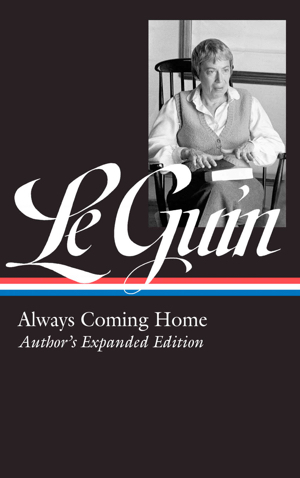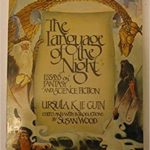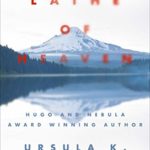When Samuel R. Delany reviewed Ursula K. Le Guin’s Always Coming Home on its publication in 1985, he referred to science fiction as a dialogue between present and future. That happens to be a good way of thinking about this unique work. It is part imaginary ethnography and part literary anthology of a people, the Kesh, who “might be going to have lived a long, long time from now in Northern California.” The book is also part commentary on how the imagination combines fact and fiction. It portrays in rich detail a culture that might take the place of the one we know while using remnants of a lost society like our own.
Compendium of a Future Culture
Rather than explain this future world in a continuous narrative, Le Guin presents numerous examples of Kesh cultural and artistic practices. There are stories, poems, songs and one extended narrative. In a section called the Back of the Book, there are descriptions of Kesh language, kinship, religious practices, music, clothing, food, houses and much else that helps explain their complex culture. The original edition also included a recording of Kesh songs.
Though imbued with stories of Native American life by her anthropologist father, Alfred Kroeber (author of Handbook of the Indians of California) and her mother, Theodora Kroeber, who wrote ISHI In Two Worlds: A Biography of the last Wild Indian in North America, Le Guin rejected the idea of copying a Native American culture and pasting it into the future. There are echoes of native cultures (such as a Coyote figure) in Kesh stories and practices, but for the most part Le Guin created something new. She envisioned a culture blending respect for nature with the self-sustaining remnants of a technological society.
Pandora’s Commentary
Le Guin ties together the disparate elements of this compilation through the editorial efforts and commentary of Pandora, a cross-cultural interpreter who is very much the artist shaping our introduction to this future world.
Pandora is at once a contemporary of ours, interpreting the People’s culture like an anthropologist, but also an interviewer of the People of the Na Valley (based on the Napa Valley of California where Le Guin spent much of her childhood). She records their stories and songs and helps us reconstruct in our imaginations the villages and physical structures of their world, which does not yet exist in ours. So she is also a being out of time who reflects upon her role and worries about what she is doing.
She recoils from looking through the narrow end of the telescope, as she puts it, where everything looks ordered and doll-house like. She wants to run out to touch and hold things, to feel their weight, not to think of them intellectually but hold them in mind, not look for spiritual realities but to feel the heaviness of things.
Our language, she seems to say, and our minds want to grasp things abstractly, see them as wholes but have trouble looking into the thousands of tiny details of which the landscape is made. And so she has given us so many details to grasp but few of the generalizations that the mind wants to formulate. She asks the reader to live in the concrete details of this future world but also offers enough by way of explanation to pose tantalizing questions about our present.
The City of Mind
The Kesh people and their neighbors live amid the remnants of past civilizations. Although they live mostly in a farming and handcraft culture, there are trains that run on wooden rails, indoor plumbing and electricity and, most spectacularly, an extensive system of computers. These form a network that is fully automated and self-regulating, comprising “communities of cybernetic devices or beings”. There are access points to the network, called exchanges, all over the planet.
The Kesh use them to download information about any form of technology they wish to use, though they do this sparingly, and in return upload information about their lives and culture. The system contains comprehensive information about all human cultures, every branch of science and all forms of technology. The Kesh call this network, which is capable of conscious, self-directed evolution, the City of Mind in contrast to human civilization, the City of Man.
Stone Telling’s Life-Story
Le Guin invites the reader to get into the book in any way they choose. Each time I approach Always Coming Home, I start at a different point. Like most who look to fiction for a good story, I first began with the longer narrative about the life of Stone Telling. The length of a short novel, the story is broken into three parts and interspersed with numerous examples of Kesh poetry, songs, stories and descriptions of fundamental beliefs.
The narrator, whose name in old age is Stone Telling, presents the story of her learning how to be human, moving from her childhood to her rebellious teen years into her late twenties. She grows up in the household of her Kesh mother but is drawn to her father of the warrior Dayao people when he revisits his family after many years’ absence.
Feeling alienated from her mother, who is distant, she is drawn to him partly because he has come back after long absence to see her. She persuades him to take her with him to live in a city far north of the Na Valley. Even though she leaves her mother behind in anger, as she makes the long journey to the north (probably around Mt. Shasta), she feels the pull of the valley. It’s like leaving her body behind, reducing herself to a weightless entity.
Contrasting Cultures
She soon learns that the Dayao have no respect for women and keep them shut indoors, regarding them as having value only for the children they bear. Her father is a favorite general of the Condor, the absolute ruler of the Dayao people, and he travels frequently on military campaigns.
Their whole society starkly contrasts with the life she has known. The Kesh believe in a constant exchange with other living things, cultivation of the arts and writing and a rich ceremonial life shared by all. The Dayao women and children must stay indoors, away from nature. Neither they nor anyone else except for the Condor himself is allowed to read or write. That is because this society is guided by power, and the power of words is another dimension of the perfect being of the God they worship, known as the One.
They restrict access to all knowledge, limiting its sources to the household of the Condor. The people never discuss issues in public to reach agreement but rely wholly on their leader. Though the warriors, all men in this militarized society, travel constantly on their campaigns to subdue other lands, they never learn how other people live. They see other peoples as beneath them and good only to be turned into slaves. They think in binaries (either/or) and are not comfortable amid the diversity of living things.
Woman Coming Home
She has an arranged marriage and gives birth to a child, but has little feeling for the man she has married. She decides to leave that world and return to the Na Valley. Her slow journey reawakens her to the ways of being in the world that she has missed. The experience is so powerful that she renames herself Woman Coming Home.
This is not just a story of coming of age but of learning what it means to be a person. It is a great theme that recurs throughout the varied writings Le Guin has assembled, including the many shorter life stories and the fragment of a Kesh novel, called “Dangerous People.” I have never encountered so rich a dramatization of what it means to realize the self within the context of a particular place and a finely imagined culture.
Merging Reality and Imagination
The new Library of America edition of Always Coming Home includes a further section of essays and stories selected by Le Guin that offers insight into the way she approached this book. She added one story that she says showed her the way to write about this world, even though ultimately she found no place for it in the finished product.
“May’s Lion” is an excellent place to find a way in for the reader, just as it was for Le Guin. In a prefatory note, she rejected the usual “trickster’s” way of moving from the reality of the Napa Valley she knew to the imagined Na Valley of the future by “concealing the connection,” between the factual and the imaginary. Instead, she decided to leave that connection out in plain sight.
She tells the story of May, an elder neighbor, finding a mountain lion under the fig tree near her house. May figured it was ill and was looking for a place to die. It stayed there all day and kept her in the house, unable to get to the nearby pasture to milk her cow. Finally, at a loss for what to do, she called the sheriff, who arrived with deputies and guns. They were at a loss too but wound up doing the only thing they knew how to do. They shot and killed the lion. May didn’t want that, but she just didn’t know what else to do.
Stepping Outside History
Le Guin then retells the story by taking May and the lion outside of history, as she says, and putting them into the Na Valley, where May’s name means Rains End in the Kesh language and she has been a healer for many years. She waits patiently to observe the lion under her fig tree and decides that he has probably come there to die. She doesn’t know the songs of mountain lions, but she sings for him the songs that humans use when they are dying. Rains End falls asleep sitting on the porch of her house, and in the morning sees that the lion ‘had finished his dying” and so she sings the last song over him. Later she gets help from friends to carry the lion out “where the buzzards and coyotes could clean it.”
It’s a beautiful story that connects with the reader without a lot of background explanation, in much the way that the poems, songs and stories of Always Coming Home do. This is a book that demands to be reread and that only grows in richness through the encounter with more details and stories of Kesh culture.




Leave a Reply